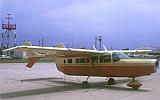
 |
|
|||||||
| Register | FAQ | Members List | Calendar | Today's Posts | Search |
 |
|
|
Thread Tools | Rate Thread | Display Modes |
|
|
|
#1
|
|||
|
|||
|
Long range capabilities of 337 and modifications
As I understand it the bog standard early 337 models came with a 128 gallon tank. The later factory long range ones had a 148 gallon from what I can understand.
Aviation Enterprises website says they can fit up to 408 gallons into a 337 and I was wondering where all that would go! Some it seems goes into under wing pods. Anyway, it piqued my interest and I now need to turn to the expertise on this forum for answers. Can someone explain to me what the modification options are within the wing? What's the capacity one can fit in there at the most? And is it better to go with a wingtip extension combination or something else? Also, are there baggage compartment aux tanks available like you can get for the single Cessnas? I haven't found any such online, but maybe there's a source I haven't found? I'm researching the feasibility of getting 1700nm range out of it, which would help her get directly from Shannon to St. Johns or to do the southern Azores transatlantic crossings in the winters. I've calculated that at optimum range (125kts) it would burn about 14 gallons/hr, which would make the total needed around 190 gallons on the Shannon-St-Johns route, with no winds. You want at least 2-3hrs on top of that, which brings you to 220-230 gallons. Now, would that fit into the wings with modifications?
__________________

|
|
#2
|
||||
|
||||
|
Realistically I'd plan for 18 gals/hr...but more like 20 to play it safe.
|
|
#3
|
||||
|
||||
|
I wouldn't quarrel with the 14 gal/hr at the reduced 125 kt speed and assuming lean-of-peak operation (which requires matched injectors such as GAMI, cylinder-by-cylinder engine monitoring and a knowledgeable pilot). And "stratobee" has put the margin in the additional 2 - 3 hrs that he's budgeting.
I wouldn't do it myself, but the numbers look OK. Ernie |
|
#4
|
|||
|
|||
|
I'd like to ad that I wouldn't fly that route myself, I'd have it ferried by a more experienced pilot. It's just that if it does that trip more than twice, then the mods probably make sense compared to the hassle of a ferry tank. Obviously there's always the northern route that needs no mods at all, but at winter that can be hazardous.
__________________

|
|
#5
|
||||
|
||||
|
Holy crap. What a waste of money and effort.
|
|
#6
|
||||
|
||||
|
Ferry Tanks
Your best shot is internal, inside the cabin, Ferry Tanks.
These are custom made, will require some plumbing and pumps, to get the fuel to your wing tanks. Owen adds internal to the wing tanks outboard of the current tanks. These are small tanks, several of them, in each wing. With each tank there is a fill port, and a fuel drain, both of which add to the drag on the airframe. Then there are the wing extension tanks. These are ever further outboard of the wing end. Finally, there are the under the wing tanks, attached with hard points under the wing. All of these tanks require additional plumbing, and pumps to work. The deal about all of those is that they are expensive, they are modifications to the airframe, that place additional loads on the wing, in an area that is not necessarily designed to take those loads. In addition, when you are all done, they are there forever. If you get an internal ferry tank, you can take it out when you reach your destination. You can take off at 30% over gross weight, and not affect the drag that is on the airframe. I remember listening to someone talk at the last Bahamas fly-in about flying from St. Johns to the Azores. It was the shortest route to go to Africa. There was a temporary installation of a HF radio, mounting it up in the cabin overhead. The route is direct, over well traveled shipping lanes, and avoided all the potential for icing that can be found on the northern route. In the fuselage tanks were used by the AF to ferry 0-2's to Viet Nam. I would suggest talking to Don Nieser about installing a fuselage tank. I think for long distance, this is your best bet. |